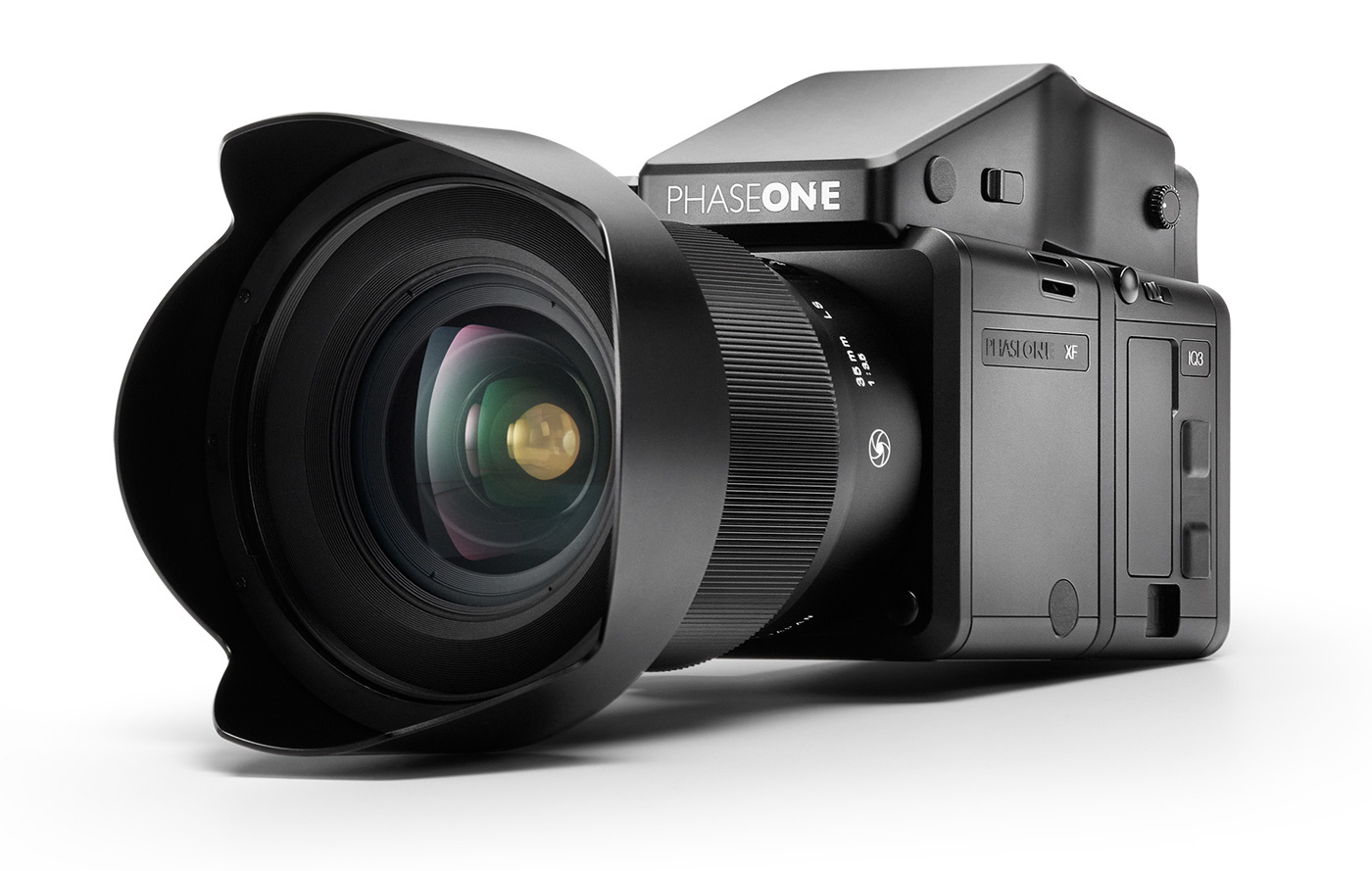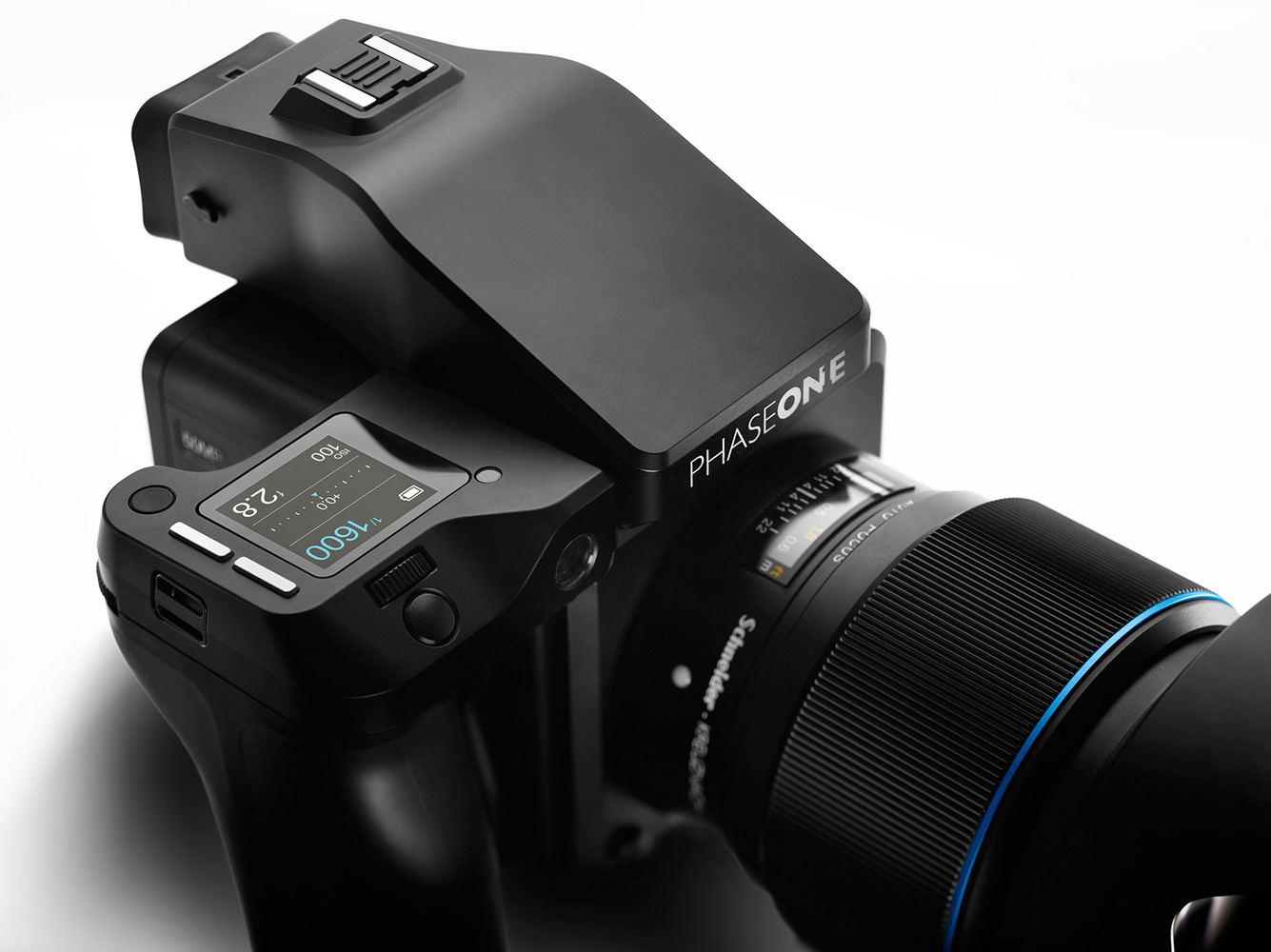A major announcement by Phase One has introduced an entire system of state-of-the-art products to their lineup. The all-new, highly anticipated Phase One XF camera body has arrived, along with new IQ3 digital backs, new Schneider Kreuznach 35mm f/3.5 and 120mm f/4 leaf shutter lenses, and an updated Capture One 8.3. This fully modular platform brings advancements in autofocus, power sharing digital backs, highly customizable user interfaces, and much more.
In the debut press release, Phase One President and CEO Henrik Håkonsson likened the newly released XF camera system to that of a “Stradivarius in the hands of an expert.” This exemplifies both the attitude and direction for what Phase One is attempting as well as sets customer expectations remarkably high.
XF Camera Body
With an all-new electronics architecture, gyroscopic and accelerometer sensor advancements, custom processor autofocus platform, modular viewfinders (including a waist-level finder option), capacitive touchscreen display, eighty-plus custom settings, three customizable physical dials, six customizable physical buttons, and a built-in wireless Profoto flash trigger; there’s a lot to love in the new XF camera body.
Phase One is also ensuring users that fast and easy upgrades will be available for the camera’s operating system at regular intervals. Pairing this highly-modular system with a 5-year warranty, Phase One makes it clear they intend the XF platform to be used and enjoyed for a long time to come.
Honeybee Autofocus Platform
The Honeybee Autofocus Platform (HAP-1) was developed in-house and will make its first appearance in the XF camera. The HAP-1 uses a 1MP CMOS sensor with a custom floating point architecture processor. The camera features a HAP-1 Precision white spectrum focus assist light and has upgradable autofocus configurations and patterns. Autofocus modes include spot, average, and hyperfocal. The Hyperfocal Point Focusing feature allows a user to register a custom hyperfocal point for each lens and then autofocus to that point at any time when needed. Focusing screens are interchangeable between the default matte, split, and center prism options.
OneTouch User Interface
The XF camera body blends touch display technology with physical controls to create many strengths and eliminate as many weaknesses as possible. The 1.6 inch transflective grip display and 3.2 inch digital back display are now both touch enabled providing simple operation to the user, such as single-tap 100-percent zoom on image previews. There’s a front, side, and rear dial, along with six buttons placed around the body. The controls are “soft-configured” and unlabeled, meant to be programmed to personally suit the user’s needs.
The camera may be further customized through eighty programmable settings, three custom mode configurations, and two standard screen layouts. The OneTouch UI will be updatable via digital backs.
IQ3 Digital Backs
Along with the Phase One XF camera body, also introduced are the IQ3 digital backs in 50-megapixel, 60-megapixel, and 80-megapixel varieties. The 50 and 60-megapixel IQ3 backs are exclusively created for the XF mount, whereas the 80-megapixel back will have XF, H, and V mount options. Phase One IQ3 digital backs include a unique high-bandwidth port for faster data transmission and are capable of power sharing between the system’s two batteries. Another one of the distinctive features of the IQ3 backs are their ability to shoot up to one-hour single exposures. All three are also Wi-Fi enabled which allows for wireless capture using the Capture Pilot app on iOS. Other specifications of these backs align similarly with those of the IQ1 range. Phase One has made available a PDF that shows all of the IQ3's technical specifications and comparisons with previous digital backs in their lineup.
Schneider Kreuznach Leaf Shutter Lenses
Presented as “ready for 100-megapixels and beyond,” the new 35mm f/3.5 and 120m f/4 Macro leaf shutter lenses try to answer the needs of today and tomorrow’s technology.
| 35mm LS f/3.5 | 120mm LS f/4 Macro | |
| Aperture Range | f/3.5–f/32 | f/4–f/32 |
| Angle of View | 89˚ | 33˚ |
| Focusing System | AF / MF | AF / MF |
| Filter Size | 105mm | 72mm |
| Optical Construction | 11 Elements 8 Groups |
9 Elements 8 Groups |
| Lens Hood | Bayonet | Bayonet |
| Flash Sync (using LS) | Up to 1/1600s | Up to 1/1600s |
| Max. Shutter Speed (using FPS) | 1/4000s | 1/4000s |
| Dimensions (LxW) | 111mm x 119mm 4.4" x 4.7" |
51.5mm x 80.5mm 2" x 3.2" |
| Weight | 1370g 3.02lbs |
960g 2.12lbs |
| 35mm Equivalence | 22mm | 75mm |
| Min. Focus Distance | 0.5m / 1.64ft | 0.37m / 1.21ft |
| Max. Magnification Ratio | 0.104x | 1.00x |
| Area Covered (WxH) | 518mm x 390mm 20.4" x 15.3" |
56mm x 42mm 2.2" x 1.6" |
| Mount | XF 645 Bayonet | XF 645 Bayonet |
| Supported Systems | XF, P1, M 645DF/DF+ | XF, P1, M 645DF/DF+ |
| 2x Teleconverter | No | No |
Capture One 8.3
New Phase One digital backs to support means it’s a good time to push an update for Capture One. Capture One 8.3 brings tethering and file support for the IQ3 backs, file support for the Olympus TG-4, preliminary file support for the new Canon 5DS and 5DS R camera bodies, and DNG 1.4 support. New lens support has also been added for the Schneider Kreuznach Macro LS 120mm f/4 mentioned above, as well as the Nikon 28mm f/1.8G and Nikon 60mm f/2.8G.
Alongside bug fixes and stability improvements, Capture One 8.3 brings a few new feature enhancements. For one, Phase One says tethered shooting is now 30 percent faster. Additionally, there’s a new high-performance tethering engine for Apple Macs, a modernized capture tool, improved camera settings tool, and IQ-style grid modes.
Pricing and Availability
The following prices are dependent on the IQ3 digital back of your choosing, but all are configured with the XF camera body, IQ3 back, prism viewfinder, and Schneider Kreuznach 80mm leaf shutter lens.
- XF IQ3 80MP: $48,990.00 (38,990.00 EUR)
- XF IQ3 60MP: $41,990.00 (33,990.00 EUR)
- XF IQ3 50MP: $40,990.00 (31,990.00 EUR)
XF camera system configurations are available now through Phase One partners worldwide.
Both new high-resolution lenses, the 35mm LS f/3.5 and the 120mm LS f/4 Macro, are priced at $6,490.00 (5,490.00 EUR).
Owners of Capture One Pro 8 are eligible to update to Version 8.3 for free. If you have an earlier version, upgrading will cost a discounted $99. New customers can purchase Capture One Pro 8.3 for $299, or $10 monthly for 12 months if you prefer a subscription-based payment model.














It looks so much like they recycled the design for the Mamiya 645 super. It's so boxy. I wish I had the deposit money to rent one of these for an hour.
I was just thinking, it looks like an RZ with a grip. I like it!
Does anyone else think this looks like cheap plastic?
40.000 ehmm... + 6500 for lens... i could buy quite nice apartment here in my city +)
I may be in the minority, but I like the styling of it. Price tag, not so much. I would have to admit to a desire to spend some time using one of these just for fun...
ill take one with the waist level VF!! in my dreams..
Man, I love the look of the WLV, but I just can't get past the whole mirrored image thing! I know it takes time, but I feel absolutely dumb panning the wrong way to compose
I have honestly never used one before but I have always loved the idea of using one!
But can it shoot 4k or 8k video is what.....>>>>>(running for the exit) :O
Am I missing something? Not a single mention of frames per second?
CMOS or CCD?
The sensor types haven't changed for the lineup. Like the IQ1, the 50MP IQ3 uses a CMOS sensor whereas the 60 and 80MP backs use CCD. There is a PDF from Phase One that shows all the technical specs of the new backs and comparisons here, but what I listed in the article are the differences from the prior lineup: https://www.phaseone.com/~/media/NEW_WEB/Tech-Spec/XF/XF_Technical_Specs...
Meh, it has no flip-up screen for selfies...
30% faster on the tethering? How much faster can it get? Pretty soon the pictures in my head will be showing up on my screen.
I'm "old" maybe, but I just don't want that much data. I'd love a Medium format sized digital camera for the optical differences between small & medium format, but I'd prefer something around or sub-30MP, tbh. When you get more resolution, you need to be more critical with regards to shutter speed/stability and EXACT focus (if you're into that sort of thing.) Me, I want some room to breathe.
I think I may have to buy one...
Honest question: has anyone experienced or understand any discernible difference between PhaseOne's CCD 13-stop dynamic range vs their CMOS 14-stop dynamic range?
If only I had 40k lying around. Can't wait to rent these out for some summer shooting.